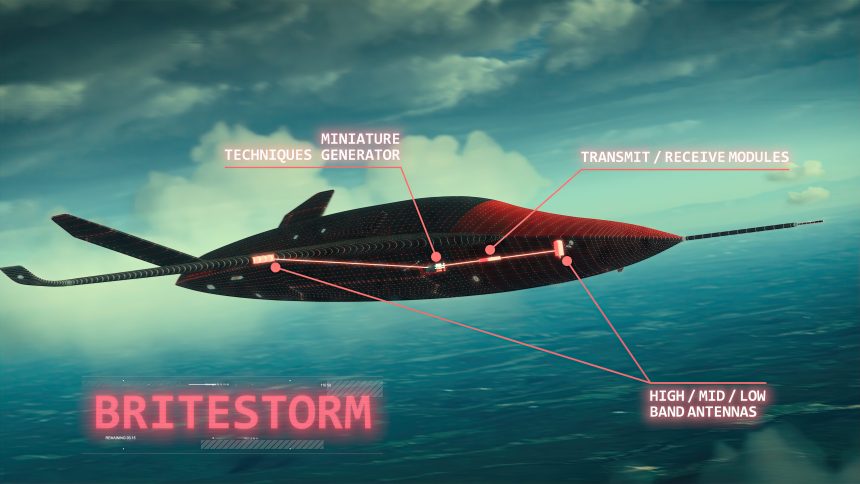BriteStorm is an advanced digital electronic warfare payload designed by Leonardo to be deployed on UAVs and launched effects, providing high-powered jamming and deception techniques to suppress and neutralize modern Integrated Air Defence Systems (IADS).
Leonardo, one of world’s the largest defense and aerospace companies, has introduced a groundbreaking new product, BriteStorm, designed to enhance the effectiveness of modern military operations. BriteStorm, launched at the Association of the U.S. Army’s (AUSA) Annual Meeting and Exposition in Washington D.C., offers a cutting-edge solution for countering advanced Integrated Air Defence Systems (IADS). With its innovative airborne electronic warfare capabilities, BriteStorm enables armed forces to safely operate deep within hostile airspace.
A Revolutionary Payload for UAVs
BriteStorm is engineered to provide stand-in jamming capabilities, where it acts as an airborne disruptor against a wide array of enemy threats. Deployed ahead of the main force, the system delivers high-powered electronic interference to degrade the enemy’s air defense systems. By confusing and suppressing ground-based radar and surveillance systems, BriteStorm shields friendly forces, allowing them to complete missions with a reduced risk of detection or attack.
Key Features and Capabilities
The payload is designed to be easily integrated into a variety of Unmanned Aerial Vehicles (UAVs) and launched effects. According to Leonardo, which is a global company headquartered in Italy, what sets BriteStorm apart is its adaptability as it can be installed on multiple platforms and is compatible with various UAV types, offering militaries flexibility in deployment. Additionally, its digital deception techniques are designed to counter sophisticated radar systems by creating ghost aircraft signatures, making it difficult for adversaries to pinpoint actual threats.
At the core of BriteStorm is Leonardo’s Digital Radio Frequency Memory (DRFM) technology, a proven solution that allows the payload to detect and counter threats in real-time. The DRFM-based system continuously evaluates the electronic warfare environment, selecting the most appropriate countermeasure to disrupt enemy defenses. The payload can barrage enemy radars with noise or, more advanced, it can deceive the enemy by simulating multiple fighter jets, leading adversaries to misdirect their defense resources.
Collaboration with the Royal Air Force and Successful Trials
Leonardo has already partnered with the Royal Air Force’s Rapid Capabilities Office (RCO) to test BriteStorm in real-world environments.
The RAF RCO has been involved in flight trials, purchasing payloads for testing and validation. These tests have been a resounding success according to the company, demonstrating the technology’s capability to counter modern air defense systems effectively. The trials mark a major step forward in providing the U.K. with a state-of-the-art electronic warfare capability.
The U.K. Ministry of Defence sees great potential in BriteStorm, particularly given its success with Leonardo’s existing **BriteCloud** countermeasure. While BriteCloud was designed to disrupt incoming missile systems, BriteStorm focuses on radar deception, further enhancing the country’s defense capabilities against airborne threats.
Lightweight and Attritable
One of BriteStorm’s key strengths is its small, lightweight design, which makes it suitable for use in diverse operational environments. Its flexible architecture ensures that it can be easily integrated into existing military infrastructure, making it a practical option for armed forces seeking to enhance their electronic warfare capabilities. With a modular setup consisting of a platform-specific antenna, transmit-receive modules, and Leonardo’s Miniature Technique Generator, the system can be seamlessly added to a wide range of UAVs and other platforms.
BriteStorm has been engineered with a focus on cost-effectiveness and reusability, ensuring that the system can be deployed in situations where attritable (expendable or recoverable) systems are required. This makes it a highly attractive option for modern warfare, where budget constraints often limit the deployment of high-end technologies.
Applications in U.S. and Global Markets
Beyond its initial partnership with the U.K., Leonardo is eyeing the U.S. Department of Defense as a key customer for BriteStorm. Given the increasing importance of electronic warfare in contemporary combat scenarios, BriteStorm offers a distinct advantage in contested environments, allowing U.S. forces to maintain dominance in electronic warfare engagements.
The payload is designed to be readily exportable, with demonstration units already available in the U.S. Leonardo anticipates significant interest from other markets, including Europe, the Middle East, and Asia-Pacific, where advanced air defense systems pose a growing threat to military operations. The ability to tailor BriteStorm’s capabilities to specific mission needs makes it an appealing choice for a wide range of international customers.
Digital Transformation and Future Outlook
BriteStorm is the product of Leonardo’s company-wide “digital transformation initiative”, which seeks to harness the power of modern technologies to create more effective defense systems. The development team has applied digital innovations to ensure that BriteStorm remains at the forefront of electronic warfare capabilities while maintaining its flexibility and scalability.
As the battlefield continues to evolve, the need for autonomous and electronic warfare systems like BriteStorm will only grow. With UAVs playing an increasingly prominent role in military operations, as shown in Ukraine and the Middle East, the integration of sophisticated jamming systems will be critical to maintaining an edge over adversaries. Leonardo’s BriteStorm promises to be a vital asset for armed forces around the world, providing them with the tools they need to overcome modern air defense challenges and execute complex missions successfully.
As testing continues and new markets open up, BriteStorm or similar technologies offering integration of electronic warfare capabilities with UAVs, are poised to become a central component of next-generation warfare strategies.









